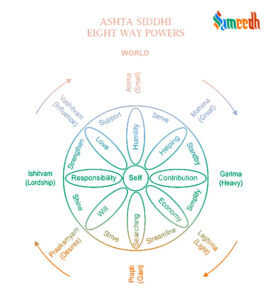Mahima Siddhi specifically refers to the ability the ability to become infinitely large or to expand one’s physical form to immense proportions. Those who attain this siddhi are believed to have mastery over their physical body to the extent that they can enlarge it at will, surpassing the usual limitations of size and space.

In Hinduism, Mahima Siddhi is another one of the eight primary siddhis mentioned in various scriptures, particularly in texts like the Yoga Sutras of Patanjali and Tantric texts. Mahima Siddhi refers to the ability to become large or expand in size.
Like other siddhis, Mahima Siddhi represents mastery over the physical body and control over the material world. It symbolizes the profound potential within each individual to transcend the limitations of physical existence through spiritual practice and discipline.
It is the polar opposite of Anima Siddhi. One can grow into an enormous size with this power. It can be as gigantic as the Universe itself and naturally with such a large body would come great amounts of strength. To get medicinal herbs from Sanjivani mountain to save Laxman, Hanuman expanded into a massive size for carrying the entire mountain.
Here are a few popular stories and myths that touch upon the idea of Mahima Siddhi:
- Hanuman and His Giant Form: In the Hindu epic Ramayan, there’s a lesser-known episode where Hanuman, the loyal devotee of Lord Ram, demonstrates his ability to manifest a colossal form. During the battle between Ram’s army and the demon forces of Ravan, Hanuman assumes a gigantic size to strike fear into the hearts of Ravan’s army. This incident showcases Hanuman’s extraordinary powers and his ability to change his physical form, reflecting themes related to Mahima Siddhi.
- Vaman Avatar of Lord Vishnu: In Hindu mythology, Lord Vishnu incarnates as Vaman, a dwarf Brahmin, to subdue the demon king Bali. In the legend, Vaman approaches Bali and asks for land measuring three steps. When Bali agrees, Vaman assumes a massive form, expanding to cosmic proportions, and covers the entire universe in just two steps. This story illustrates the idea of divine beings manifesting immense forms, akin to the concept of Mahima Siddhi.
- Lord Krushna’s Vishvarup: In the Bhagavad Gita, during the discourse between Lord Krushna and Arjun, Krushna reveals his universal form (Vishvarup) to Arjun. In this awe-inspiring vision, Arjun sees Krushna expanding to encompass the entire cosmos, with countless universes, gods, demons, and celestial beings manifesting within him. This depiction of Krushna’s cosmic form demonstrates the idea of divine beings transcending physical limitations and assuming vast, expansive forms.
- Durga’s Battle with Mahishasur: In Hindu mythology, Goddess Durga, the divine embodiment of feminine power, engages in a fierce battle with the buffalo demon Mahishasur. In some interpretations of the story, Durga assumes a colossal form, radiating boundless energy and power, to vanquish Mahishasur and restore balance to the universe. This portrayal of Durga’s magnificent and awe-inspiring form resonates with the concept of Mahima Siddhi.
While these stories may not explicitly focus on Mahima Siddhi, they contain elements or themes that align with the idea of beings assuming immense forms or transcending physical limitations, which are central to the concept of siddhis in Hinduism.
Here are some aspects of the significance of Mahima Siddhi in Hinduism:
- Testimony to Spiritual Progress: Attaining Mahima Siddhi is considered a significant milestone on the spiritual path. It demonstrates the practitioner’s progress in their spiritual journey, indicating their dedication, discipline, and mastery over the mind and body.
- Manifestation of Divine Grace: In some interpretations, the attainment of siddhis, including Mahima Siddhi, is seen as a manifestation of divine grace. It signifies the blessings bestowed upon the practitioner by the divine, affirming their spiritual growth and alignment with the cosmic order.
- Tool for Service and Protection: Those who attain Mahima Siddhi may use their abilities to serve others and protect them from harm. They can enlarge themselves to shield others from danger or to inspire awe and reverence, thereby fulfilling their duty to promote spiritual welfare and uphold righteousness.
- Reminder of Cosmic Interconnectedness: Mahima Siddhi highlights the interconnectedness of all beings and the unity of the cosmos. By transcending the limitations of size and space, practitioners of Mahima Siddhi recognize their inherent connection to the universe and their capacity to embody the vastness of creation.
- Ultimate Surrender to Divine Will: While Mahima Siddhi demonstrates extraordinary powers, it also serves as a reminder of the ultimate surrender to divine will. Practitioners must use these powers selflessly and in accordance with dharma (righteous duty), acknowledging that true fulfillment lies not in the attainment of siddhis but in union with the divine.
Overall, Mahima Siddhi holds significance in Hinduism as a symbol of spiritual mastery, divine grace, and the boundless potential of the human spirit. It underscores the transformative power of spiritual practice and the ultimate goal of realizing one’s inherent divinity.